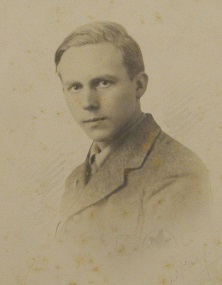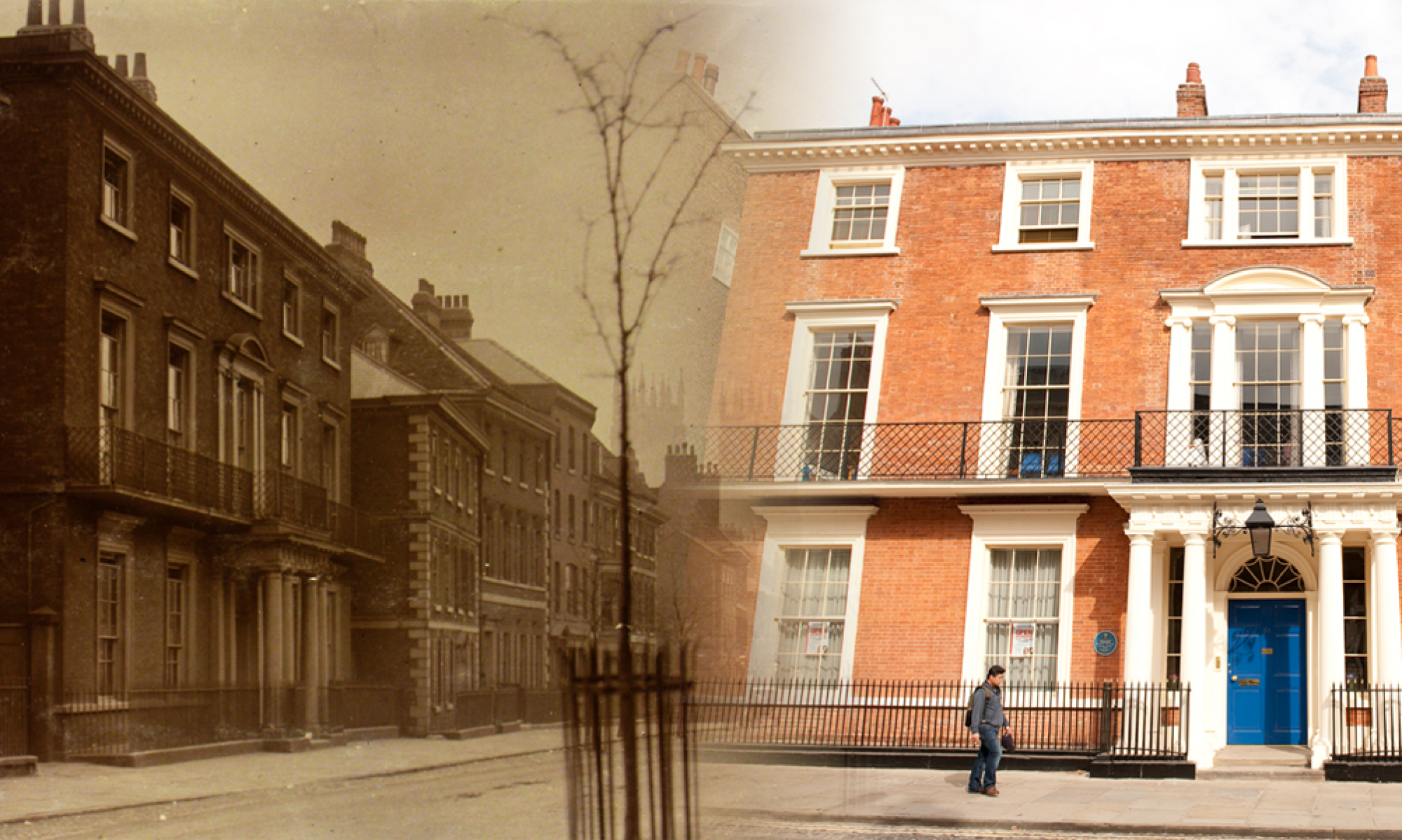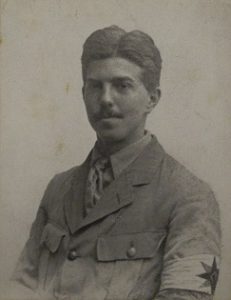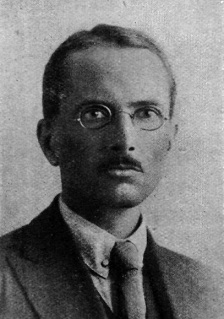
Ralph Vipont Brown of Manchester was with the Friends War Victims Relief Committee and died of pneumonia following influenza on the 1st March 1919 in Calais, aged 20 years.
Ralph was born in Manchester in 1898 and attended Bootham School from 1912 to 1916.
He joined Bootham in the Autumn term 1912. In the Christmas Show of 1912, Ralph won a Workshop prize for Bed Table.
The school magazine, “Bootham”, of March 1914 contains the report of The Eightieth Annual Report of Bootham School Natural History, Literary & Polytechnic Society. In it we read, under Gardens:
“Considerable interest has been taken in the gardens during the year, and they have flourished accordingly. Several new arbours have been made, that of C. R. and R. V. Brown deserving special mention.”
and under Photography:
“LANTERN SLIDES.—The best lantern slides were those entered by R. V. Brown, who shows a uniformly good series.”
He won a Workshop prize for his Book Trough.
The March 1915 issue of Bootham tells us that in the School Photography competition:
“Several interesting enlargements were sent in, of which much the best is Ellis’s view of the Swimming Bath. R. V. Brown’s picture of a Hay-wain is placed second. It would be improved by the removal of some of the foreground.”
and
“Only two sets of lantern slides were sent in, of which O. B. Ellis’s take the first place and R. V. Brown’s second. The chief criticism the judges have to make in this section is that slides should be spotted so as to show the way in which they are to go into the lantern.”
Ralph played football at school. The June 1915 issue of “Bootham” tells us, in “Football Notes (By the Captain)”:
“BROWN, R.V.—Is a dogged half or full-back, who dashes in with vigour, and always does his best.”
The December 1915 issue of “Bootham” reports that Ralph passed the University Of London, Senior School : Matriculation Standard Examination, with a distinction in French. He also took the Silver Medallion (Award of Merit) of the Royal Life Saving Society Awards.
The March 1916 issue of “Bootham” has a report on the Football season 1915-16, with Notes on the Team (By the Captain):
“BROWN, R. V., is a stalwart defender of the second line, who comes dashing in with weight and power, causing any tricky dribbler to look lively. In grim determination he makes up anything he lacks in skill.”
Ralph left Bootham in summer 1916. His Bene Decessit entry in “Bootham” of October 1916 is as follows:
“R. V. BROWN leaves from the College Class. Last year he matriculated, and this year obtained his first M.B.—the first from Bootham. He was an exceedingly hard worker, and ploughed along through thick and thin. At football he obtained his 1st eleven colours, and took an interest in tennis, on which committee he served. He was a member of the Photographic and Gardens Committees, and of the Fire Brigade. He was a reeve.” *
*A reeve is equivalent to a prefect, at Bootham School.
The same issue has Examination Results for Midsummer 1916:
“University of London, First Examination for Medical Degrees.
R. V. Brown.
R. I. A. Hickes.”
The same issue also contains the following, in “Bootham Oversea”:
“The work of the same committee in France, Holland, and Corsica progresses satisfactorily, and in all sections O.Y.S. are at work, the two most recent O.Y.S. to join the work in France being STANLEY W. DAVIES (1908-1912) and RALPH VIPONT BROWN (1912-1916).”
while “Across the Months” in the same issue tells us:
“R. V. BROWN and J. CUTHBERTSON are in training at Jordans for F.A.U. and F.W.V.R. work.”
The March 1917 issue of “Bootham”, in “Across the Months” tells us that:
“R. V. BROWN is doing War Victims’ Relief Work near Sermaize.”
and
“EARLY in February we were glad to welcome some Old Boys from the Glenart Castle. The boat was in dock, so they were able to tell us about work in the Near East and in the Channel. V. W. ALEXANDER was accompanied by A. L. WILSON , R. BROWN, and E. RANSOME. They showed a fine set of slides representing F.A.U. work to the School and to the orderlies.”
“Bootham” of June 1917 contains the Report of Old York Scholars’ Association Whitsuntide Meeting, 1917:
“Messages were then read from Old Bootham Boys serving abroad, and cordial greetings from the Association were returned to these:
” To Bootham School, York, Angleterre.
” Meilleurs salutations de deux war victims and deux F.A.U., se trouvant dans la meme ville.
” AUBYN PUMPHREY.
” RICHARD BARROW.
” ROBERT SCRIMGEOUR.
” RALPH BROWN.” “
In the December 1917 issue of “Bootham” we read in “Bootham Oversea”:
“R. VIPONT BROWN (1912-16), speaking of the “War Victims” (of which he is one), says : ” . . . As I expect you know, we are all divided up into different departments— Building, Construction, Transport, Medical, Relief, and Agricultural Sections. When I came out here last January I was in the Medical Section a t **** * Hospital. Please do not picture to yourself a large establishment fitted with electric light and hot water. No ; we have no Haxby Road accommodation at * * * * * ” Obedient to the call of duty elsewhere, the writer continues : “Here I spent most of my time carrying armfuls of babies from the ward to the garden and back again. I also did … a good deal of motor driving. Of the two—i.e., cars and babies—I think I infinitely prefer looking after cars. The relief work has changed considerably of late from the distribution of necessities to the promotion of co-operative industry in the form of ‘Broderie.’ Building has, like the former relief work, practically ceased, and has removed to other districts.
“.. . The Agricultural Section, which, in my opinion, forms a very important part indeed of the work of reconstruction . . . consists chiefly of the provision, repair, and staffing of agricultural machinery, and requires a considerable degree of tact in dealing with the farming population in the villages in which we work. “”
and
“A. H. PUMPHREV (1905-10) sends names of O.Y.S. serving with him under the “War Victims’ Committee” : N. E. BROOKS, S. W. DAVIES, W. SHEWELL, E. G. WEST , R. V. BROWN. He says : ” We have been helping the civil authorities in a large town right up near the lines, first of all by evacuating the civil hospital. .. . It seems such a privilege to be able to do something to help those fine people who have been through such a trying three years. The work has its thrills. . . . The night before I came away we had two shells on the building over our heads while we were sleeping in the cellar! “”
“Bootham” of May 1918 contains O.Y.S. War-time Service Lists.
“Old York Scholars serving with the Friends’ War Victims Relief Committee.
Brown, R. Vipont, France.”
The July 1918 issue of “Bootham” contains the report of the Old York Scholars’ Association Whitsuntide Meeting, 1918: Jordans. Saturday, May 25th, 1918.
“Messages received by letter and telegram from Old Boys abroad were then read:—
” Boot Ham (sic) School, York, Angl.
” Meilleurs salutations a York School de War Victims dans Marne et Meuse. “
” ERIC HINDE.
” RALPH BROWN.
“GEORGE GILLETT. “”
In “Bootham” of December 1918, in “Across the Months” we read:
“RALPH VIPONT BROWN (1912-16) is said to be “wielding an immense camion, dashing along these eternal roads at the feverish rate of 12 m.p.h. His load may consist of anything from potatoes to mattresses, with one or two unfortunate équipe housekeepers packed inside, after a day’s shopping in the metropolis. All F.W.V.R. men in his section are busy preparing schemes for reconstruction in the new Verdun area allotted them.”
Then in “Bootham” of August 1919, under “Deaths” we have:
“BROWN.—On the 1st March, 1919, while serving with the F.W.V.R. in France, Ralph Vipont Brown (1912-16), of Manchester, aged 21 years.”
In the same issue is his “In Memoriam” piece:
“RALPH VIPONT BROWN (1912-16). Ralph Vipont Brown came to Bootham in the autumn of 1912, when he was nearly 14 years of age, and was a scholar there for four years. After leaving York he went for a few months to work in the F.W.V.R. warehouse in London, and at the beginning of 1917 left for work in France. From that date until his death, he was working for the “Mission,” spending himself as we who loved him knew how he would, in the service of others. At first he was occupied with orderly work at Chalons, but later at Sermaize, where the work was either stores or garage or driving—mostly motor work. He had been home on leave for Christmas of last year, and in the joy of the family reunion they had talked over the future, and Ralph had spoken with bright hopes of his medical studies after leaving the F.W.V.R. But the latter was ever uppermost in his mind, and he did not know how he would tear himself away from it. Early in the year he returned to France, and at the end of February was at Calais awaiting the arrival of some motor lorries from England. While there, however, he fell ill of influenza which speedily developed into pneumonia, and in less than a week he passed away. The end came on Saturday, March 1st.
I feel that anything I can say of his life will be altogether inadequate. Those of us who knew him at school soon learnt to love the open-hearted loving personality, ever ready for fun, yet with a deep current of seriousness flowing beneath the surface, and with such a broad and comprehensive outlook on life. I never once remember hearing him grumble or speak disparagingly of another. Patient and hard-working, both in and out of school, his radiant personality predominated over everything, and his bright face and cheery laugh were loved by all who knew him. He could enter into the trouble of others ; I remember now the cloud that came over him when the old man, Keir Hardie, died. It was the people and those who strove for them whom Ralph loved.
And so we are not surprised as we read the testimony of those who worked with him in France. The same loving, helpful disposition, transforming “daily monotonous tasks into a great work for Peace, and the brotherhood of humanity.” “Life with him was always different from when he was not there.” ” He had too, a wonderful power of getting to know the French people and fully entering into their joys and sorrows.” One feels that such a life as his is the only way of reaching down to the hearts of men, of laying the foundations of that city of God, where all men shall be as brothers.
One who knew and loved him wrote of his work in France :
“I can truly testify that he gave his all in that spirit for which we all so long. Rather than grieve at his loss may we rejoice in that we knew him and saw in him a reflection of the Great Spirit, which will help us, too, to live and serve as we should.”
Our hearts go out in deepest sympathy to his loved ones; but with them we can rejoice, knowing assuredly that to such as Ralph there is no death, but a passing into fuller service beyond :
Then was he made aware, by soul or ear,
Of somewhat pure and holy bending o’er him,
And of a voice like that of her who bore him,
Tender and most compassionate : ” Never fear !
For heaven is love, as God Himself is love,
Thy work below shall be thy work above.”
PR.”
Ralph Vipont Brown is buried at Les Baraques Military Cemetery, Nord-Pas-de-Calais, France.


